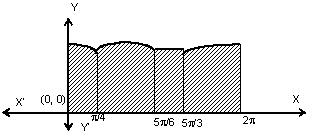Working Rule for finding the Area
|
(ii) If curve lies on both the sides of x axis i.e. above the x axis as well as below the x axis, then calculate both areas separately and add their modulus to get the total area. In general if curve y = f(x) crosses the x axis n times when x varies from a to b, then the area between y = f(x), x axis and lines x = a and x = b is given by A = |A1| + |A2| + ... + |A11| |
(iii) If the curve is symmetrical about x axis, or y axis, or both, then calculate the area of one symmetrical part and multiply it by the number of symmetrical parts to get the whole area.
Illustration 15 Find the area between the curves y = x2 + x –2 and y = 2x, for which |x2+ x –2| + | 2x | = |x2 + 3x –2| is satisfied.
|
Solution: y = x2 + x - 2 => y = 2x |x2 + x - 2| + |2x| = |x2 + 3x -2| (x2 + x - 2) and 2x have same sign Thus required area ar (PQR) + ar (ECD) = ∫0–1 [2x - (x2 + x - 2)] dx + ∫21 [2x - (x2 + x - 2)] dx = [x2/2 – x3/3 + 2x]0–1 + [x2/2 – x3/3 + 2x]21 = 7/6 + [10/3 –13/6] = 7/6 + 7/6 = 7/3 |
|
Illustration 16 Find out the area enclosed by circle |z| = 2, parabola y = x2 + x + 1, the curve y = [sin2 x/4 + cos x/4] and x-axis (when [ . ] is the greatest integer function).
Solution:
For x ∈ [-2, 2]
=> 1 < sin2 x/4 + cos x/4 < 2
∴ [sin2 x/4 + cos x/4] = 1
Now we have to find out the area enclosed by the circle |z| = 2,
parabola (y - 3/4) = (x+1/2)2,
line y = 1and x-axis.
∴ Required area is shaded area in the figure.
Hence required area = √3 × 1 + (√3 – 1) + ∫01 (x2 + x + 1).dx + 2 ∫2√3√4–x2 dx
= (2π/3 + √3 – 1/6) sq. units
Illustration 17: Let f(x) = Max. {sinx, cos x, 1/2} then determine the area of the region bounded by the curves y = f(x), x-axis, y-axis and x = 2π.
Solution:
f(x) = Max {sin x, cos x, 1/2}
interval value of f(x)
for 0 < x < π/4, cos x
for π/4 < x < 5π/6, sin x
for 5π/6 < x < 5π/3, 1/2
for 5π/3 < x < 2π cos x
Hence required area
= ∫π/40 cosx dx + ∫5π/6π/4 sin x dx + ∫5π/35π/6 1/2.dx + ∫2π5π/3 cosx dx
= (5π/12 + √2 + √3) sq units.
Illustration 18: Find area bounded by y = |4 – x2|/4 and y = 7 - |x|
Solution:
y = |4 – x2|/4 (I)
y = 7 – |x| (II)
Rewriting (I) and (II)
|
y = {4–x2 / 4 – 2< x < 2 x2–4/4 x∈(–∞, –2) U (2, ∞) y = {7 – x x >0 7 + x x < 0 Required area (PQRSTUP) = 2 area (PQRSP) = 2 [area of (OVRSO) – area of (POQP) – area of (QRVQ) ] |
|
= 2 [1/2 (7 + 3)4 - ∫20 (4–x2/4) dx – ∫42 x2–4/4 dx]
= 2 18 + 2/3 – 16/3 + 4 + 2/3 – 2
= 32 sq unit.
Illustration 19: Let f be a real valued function satisfying f(x/y) and limx–>0 f(1+x)/x = 3. Find the area bounded by the curve y = f(x), the y axis and the line y = 3
Solution:
Given = f(x/y) = f(x) – f(y) .... (1)
Putting x = y = 1, we get f(1) = 0
Now, f’(x) = limh–>0 f(x+h) – f(x) / h
= Limh–>0 f(1+h/x)/h (from(1))
= Limh–>0 f(1+h/x) (h/x)x
=> f'(x) = 3/x {since Limx–>0 f(1+x0/x = 3}
=> f(x) = 3 ln x + c
Putting x = 1
=> c = 0
=> f(x) = 3 ln x = y (say)
Required area = ∫3–∞ x dy = ∫3–∞ ey/3 dy = 3[ey/3]3–∞
= 3 (e – 0) = 3e sq. units
Illustration 20: Let An be the area bounded by y = tann x, x =0, y = 0 and x = p/4. Prove that for n ³ 2. (i) An+An-2 = 1/n–1 (ii) 1/2(n+1) < An < 1/2(n–1)
|
Solution: (i) Obviously An = .∫π/40 tann xdx An+An–2 = ∫π/40 (tann xdx + tann–2x)dx =∫10 tn–2 dt = 1/n–1. |
|
(ii) Obviously An+2< An< An-2 (from figure).
Thus 2 An = An + An < An + An-2 = 1/n–1 (by part (i)
Thus An < 1/2(n–1) . . . . (1)
Also 2 An = An+ An > An + An+2 = 1/n+1, replacing n by n+2 in (i)
An > 1/2(n+1) . . . . (2)
From (1) and (2), we get 1/2(n+1) < An < 1/(2n–1).
To read more, Buy study materials of Definite integral comprising study notes, revision notes, video lectures, previous year solved questions etc. Also browse for more study materials on Mathematics here.
View courses by askIITians


Design classes One-on-One in your own way with Top IITians/Medical Professionals
Click Here Know More

Complete Self Study Package designed by Industry Leading Experts
Click Here Know More

Live 1-1 coding classes to unleash the Creator in your Child
Click Here Know More






